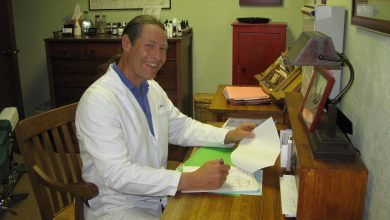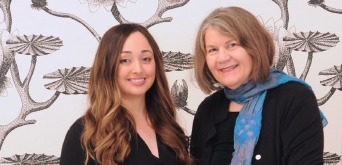Mary Ehlers
What are you looking for in massage therapy? Relief from shoulder, hip, lower back or neck aches and pains? Increased range of motion? Ease of movement? Freedom from restrictions that limit your activities? Deep relaxation? You may ask for deep tissue work or a lighter touch. You may need concentrated work in one or two areas, or a balancing overall massage. Mary Ehlers has found that myofascial release techniques get to the core of both chronic and one-time problems, and at the same time, provide deep relaxation.
I spoke with Mary to learn more about this specific, therapeutic technique and to understand the power of her healing touch.
In your last interview you told us about myofascial release. Could you tell us a little about that, as well as deep tissue work?
Myofascial release works with all the soft tissue in the body (muscles, tendons, ligaments, fascia) and combines methods from a number of other bodywork systems, including cranialsacral therapy, structural integration, and neuromuscular therapy.
One of the main neuromuscular therapy ideas it adopts is to work slowly enough so that the relaxation message can go from the muscle to the brain and back to the muscle. I find that this method also allows me to go as deep as the client likes, because I’ve got the time to feel the muscle quality (tense, loose, etc) and to feel if the muscle is ready to relax.
Another quality of myofascial work is that one can work as specifically as possible. I don’t just rub a big area and hope that helps the problem. I can find and get into exactly where the problem is.
I use deep tissue work only on people who request it – it’s not for everyone. It’s especially good for targeting deeper muscle layers and aiding with chronic muscle tension.
Please talk about how massage can play a helpful role with stress.
Massage increases oxytocin, dopamine, and endorphins, while it decreases the stress hormone cortisol. The effects are to reduce pain, reduce anxiety and irritability, increase feelings of calmness, joy, and attachment to others, improve sleep, and improve immune function. Sometimes the calmness produced by massage can give a person the break they need to deal with stress in a more productive way.
I have found it very interesting that sometimes release of a muscle can create release of an emotional stress. This happened recently for a woman who is in a very difficult relationship with her mother, but came in complaining of a very tight upper back/ shoulder/neck pain. She told me that releasing the involved muscles also released her tight hold on how that relationship “should” be, giving her a great deal of ease.
Why is massage good for seniors?
Research shows that massage significantly reduces pain, stiffness, and poor physical function caused by osteoarthritis. It also promotes circulation, joint lubrication, sleep quality, and can improve posture by reducing muscle tension. Of course, the increase in the “feel-good” hormones and reduction in the stress hormone cortisol, add to a higher quality of life overall.
I’m always rewarded by the bright eyes and smiles of my older clients who tell me how good they feel after massage. One client bent over to tie her shoe after her massage and exclaimed that for the first time in a long time, it didn’t hurt her back. For many it is a regular part of their program for health and well-being.
How can massage help a person who is seeing a physical therapist?
Physical therapists are invaluable in helping someone heal from an acute or chronic injury to a specific area. They sometimes do massage as part of their treatment, although it is just to the injured area. They also prescribe an exercise program to strengthen and stretch the muscles in and around the injury, to keep the area from being re-injured.
Massage therapy supports the PT work, by working as deeply as possible in the injured area to relax muscle tension, break down scar tissue, realign muscle fibers, and get rid of lactic acid, which causes muscle soreness. Often, tension due to the problem area spreads to the rest of the body, causing pain and soreness in other areas, which can be addressed by massage to the whole body.
Mary, please talk about the specific conditions you specialize in treating.
Upper back/neck/shoulder! That is definitely what the largest percentage of my clients come to me for. Often, their problems are caused by stress. So many of us deal with our stressful lives by tightening and raising our shoulders to our ears! Other reasons for the problems are repetitive use and overuse injuries, sitting in a head-down position for long periods, like sitting in front of a computer, and poor posture.
The next area people come for is lower back and hip aches, often caused by too much sitting, improper sitting, long car rides, that sort of thing. An exercise program to gain strength and flexibility in the lower back, abs and hips is really important to reduce this problem, but massage of all the muscles involved can help greatly on a temporary basis and can be a useful adjunct to an exercise program.
If upper back, neck, and shoulder issues are a huge area of attention for many of your clients, what are some techniques and approaches you use to assist these clients?
My basic approach for all my massage work is to work very slowly, as this allows messages to go from the muscle to the brain and back again, giving plenty of time for the muscle to get the message to relax. I also work as deeply as the client likes, up to very deep tissue work.
Let me describe a couple of methods I use often. Muscles that attach to the shoulder blade at one end and the back of the skull at the other end are particularly prone to tightness. I press slowly and deeply into the tendon which connects muscle to bone until the muscle relaxes. This can take as long as a couple of minutes. Very often the client will say “Oh, yeah, that’s the spot.” This works because there are groups of cells within a tendon, called Golgi tendon bodies, which react to sustained, heavy pressure by telling the muscle to relax.
Another method I often employ is using long, slow strokes over a particular muscle, such as the muscle on either side of the spine. There are cells within the muscle which react to pressure and tell the muscle to relax. The gliding stroke can be deep or light, to the client’s comfort.
It sounds like listening to your clients is key.
Definitely! Initially I want to find out exactly what and where their problem is and exactly what kind of massage they like. Then I really encourage them to tell me as we go if the pressure needs to change, if I’m in the right spot, if I should massage an area for a longer or shorter amount of time. It’s their massage!
What is unique about what you do?
I love the creative aspect of my work. For me, every client is different and every massage is different. Each time the client comes in, we take time for the client to tell me what their issues are at that time and what kind of massage they would like to have. I have had clients who usually want a very deep, therapeutic massage, and they’ll come in and tell me that on that particular day, they would really like a very comforting, lighter massage. Others who usually want a full body massage will come in with neck and shoulder issues and ask me to spend the whole time on that one area. Being creative in planning a massage as I go allows me to be flexible and offer a massage that is “just right.”
My myofascial and deep tissue work allows me to work much more intelligently and productively. I can go straight to a problem area and do the effective work it needs, which is good for the client and very satisfying for me.
What do you enjoy about your work as a massage therapist?
Of all the jobs I’ve had in my life, this is definitely the best! I really like working one-on-one with people and giving full attention to their desire for a wonderful massage. I get a great deal of satisfaction from being able to add to the quality of my clients’ lives. Also a massage room is a very happy place – my clients enter happy with anticipation and leave happy with their massage.
How can people get in touch with you to learn more and to make an appointment?
Call me at 541-499-1199.
Endorsements
I came to Mary because I’ve been having trouble for about 3 years with my arm and shoulder. The range of motion in my arm has been very limited. After one massage, the range of motion was about 50% better and a week later it has not regressed. I’m so happy!
-Kelly L.
I schedule regular massage appointments with Mary because of the feeling of relaxation that I always go away with. But even more than that, I believe regular massage is an important part of my health and well-being as I age. She eases the aches and pains that I develop allowing me to continue to participate in activities that I enjoy.
-M. L.
Learn More:
Mary Elhers, LMT
541-499-1199




